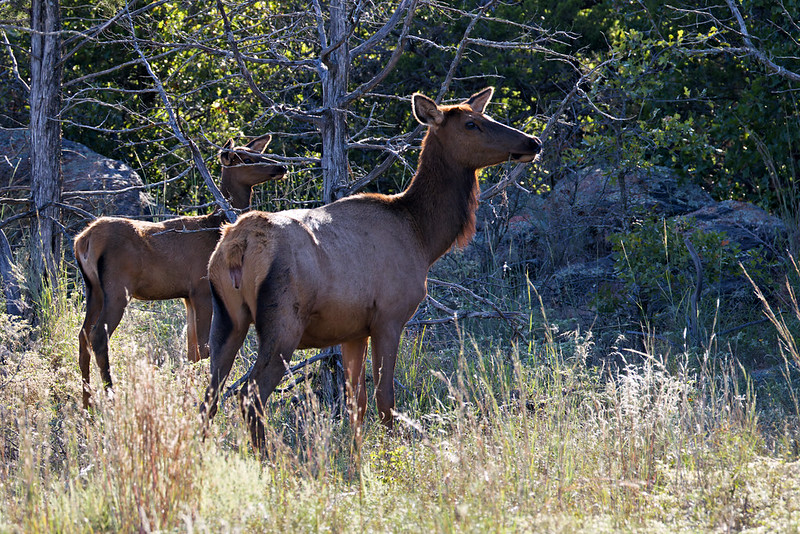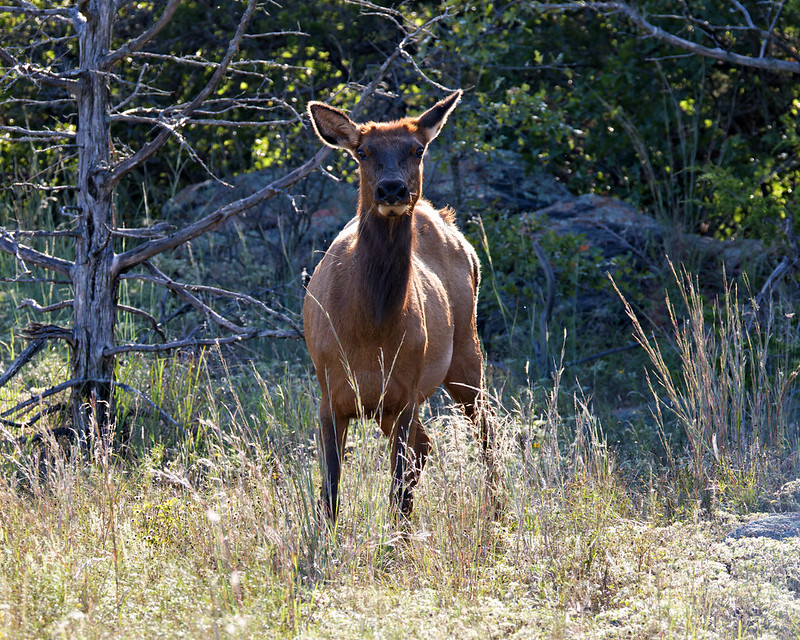My main reason for going to the Wichita Mountains Wildlife Refuge in Oklahoma last week was to photograph Bull Elk. I did so well last September (Elk Encounters in the Wichita Mountains Wildlife Refuge) so I was hoping to do well this year. As you can see in my photos below, I did photograph a couple of cow elk but no luck on the bulls. I heard the bulls bugling every day when I was at the refuge. I saw one in the distance, but the heat haze was terrible, so I didn’t get a photo.
As you can see in my previous blog post, I still had a great time photographing the other wildlife at this refuge. I still have more to share, so be sure and check those blog posts.
Here are the blog posts about last weeks visit to Wichita Mountains Wildlife Refuge in Oklahoma:
- Wichita Mountains Wildlife Refuge Lakes: Post Oak & Treasure
- Coyote at Post Oak Creek – Wichita Mountains Wildlife Refuge
- White-tailed Deer at Post Oak Creek, Wichita Mountains
- River Otters at Post Oak Creek – Wichita Mountains Refuge

Cow Elk Wildlife Notes at Wichita Mountains
The elk rut was clearly in full swing during my visit. I could hear bull elk bugling throughout each day at the refuge, their calls echoing across the landscape. The bugling is a territorial and mating call bulls make during the rut, which typically peaks in September and early October in this area.
While I didn’t get close-up photos of the bulls this trip, I did encounter these cow elk. In the first image, you can see a small group including what appears to be a younger elk on the left. The cow in the foreground has her attention focused on something in the distance, likely aware of my presence or monitoring for other potential threats.
The second photo shows a single cow elk looking directly at the camera. Her alert posture and forward-facing ears indicate she was fully aware of me. Cow elk are generally more tolerant of observers than bulls during the rut, as the bulls are highly aggressive and focused on gathering and defending their harems.

Even though I didn’t capture the bull elk photos I was hoping for, these encounters were still rewarding. Heat haze is a real challenge for wildlife photography, especially when using long telephoto lenses. The atmospheric distortion caused by rising heat can completely ruin shots of distant subjects, which is exactly what happened with the one bull I spotted.
Photography Notes: Capturing Cow Elk in Oklahoma
Camera Settings:
- Camera: Canon EOS R5 Mark II
- Lens: Canon RF 200–800mm F6.3-9 IS USM
- Aperture: ƒ/9
- Shutter Speed: 1/1000 second
- ISO: 1600 to 2000
I shot these images at ƒ/9, which is narrower than I’d typically prefer for wildlife portraits. At this aperture, I was working with the lens’s variable maximum aperture, the RF 200-800mm goes from ƒ/6.3 at 200mm to ƒ/9 at 800mm. When you’re zoomed all the way out to 800mm, ƒ/9 is as wide as you can go.
The 1/1000 second shutter speed was fast enough to freeze any motion from the elk and compensate for any camera shake at 800mm, even with image stabilization. I could have potentially gone slightly slower, but 1/1000 is a safe, reliable speed for this focal length.
The ISO range of 1600-2000 was higher than ideal, but necessary to maintain that shutter speed at ƒ/9. The R5 Mark II handles noise well at these ISOs, and the images cleaned up nicely in post-processing. The lighting conditions, backlit subjects with bright backgrounds, also contributed to needing those higher ISO values.
Both images show nice rim lighting on the elk from the sun behind them, which creates that beautiful golden outline along their backs and ears. This type of backlighting can be tricky to expose for, but it creates dramatic and appealing wildlife photos when done right.
The background separation is decent despite the ƒ/9 aperture, thanks to the 800mm focal length and the distance between the subjects and the background elements. The dead trees and darker forest provide good contrast against the elk.
